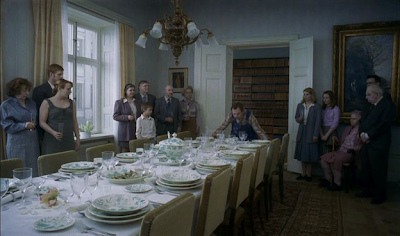
Roy Andersson's darkly funny, occasionally awe-inspiring You, the Living (2007) takes place over a few days in a colourless city where everyone is miserable for one reason or another. A school teacher breaks down in front of her class because her husband called her a hag, and the husband feels terrible for saying it. A teenager falls in love with the lead singer of a goth band, but the singer doesn't love her back. After nearly thirty years of trying to make sad people happy, a disillusioned psychiatrist tells the camera he now just prescribes pills, "the stronger the better." And so on. It says something about the film's Scandinavian flavour that a bartender calling out last orders before closing time is a structural device.
Andersson is a master of composition. He rarely moves his camera and he never goes in for a close-up. Instead, he guides the viewer's gaze primarily through his mise en scène. In one scene, an odious businessman sitting in a restaurant drones on endlessly into his cell phone ("Quality has never been for the common man"), and his position in the center of the frame, and the fact that he's speaking, make him the obvious focal point. His companion is placed closer to the camera on the left side of the screen, and occasionally turns in the direction of the camera to gaze silently at something off-screen (presumably the rain, which we hear on the soundtrack). A man sitting at the next table is positioned further away from the camera than the businessman, on the right side of the frame, but we're drawn to the movement of his hands as he softly touches the businessman's jacket. As I watched the film, I found that I was more alert to small, seemingly unimportant things happening in the frame, as in one scene where the psychiatrist walks up a set of stairs on the left side of the screen; after he disappears from sight, a door opens on the right side of the frame and some one tosses a box onto a pile of garbage, activating a part of the screen that hadn't previously been the focal point.
The film doesn't have a conventional plot. There are small clusters of scenes that are tied together by a causal chain, as when a different businessman offends an Arabic barber. The barber responds by shaving a line down the middle of his head, and then walks to a nearby café to calm down. The businessman follows the barber and starts yelling at him about an important meeting he has to go to. The barber calmly tells the businessman he'll fix it for free. In the next scene, the businessman walks into a meeting with a completely shaved head, but no one pays any notice. During the meeting, the boss has a stroke and dies. The next scene is at his funeral, and neither the barber nor the businessman is seen again. (However, a female singer who performs at the funeral turns up much later in the film, singing in her bathtub.) More often, Andersson cuts to an adjacent scene. In one sequence, a tuba player practices in his apartment, disturbing his neighbor on the floor below. The film then cuts to a man standing on his balcony in a neighboring building, where he can see both the tuba player and his neighbor. Sometimes the connections between scenes are more elusive. The film opens with a man sleeping on a couch next to an open window. On the soundtrack, we hear an approaching train. The film cuts to a bickering couple sitting on a park bench. In the background behind them is a bridge. Are we supposed to conclude that the train passed on that bridge? To make a connection between the two shots, we need to go beyond the letter of the text, either making an inference or possibly even an interpretation.
Andersson's deadpan style places everything on an even keel. The camera maintains an objective distance from the characters, and the actors are arranged in the frame so that nobody seems more important than anybody else (the scene in the restaurant is a perfect example). Rather than having a plot that builds, the film consists of a series of loosely connected vignettes. The tone is at once absurd and deadly serious, as when a man has a dream where he's sentenced to death for smashing china. As he's dragged to the electric chair, the "victim" stands up in the viewing room and repeats that the china he smashed was two hundred years old. This is only the second film I've seen by Andersson, after Songs From the Second Floor (2000), yet his style is so singular that I wouldn't hesitate to declare that he's the greatest of all Swedish filmmakers.
Monday, December 29, 2008
You, the Living
Subscribe to:
Post Comments (Atom)
You actually make it seem so easy with your presentation but I find this topic to be really something which I think I would never understand. It seems too complicated and extremely broad for me. I’m looking forward to your next post, I will try to get the hang of it!
ReplyDeleteskip bin hire yeerongpilly